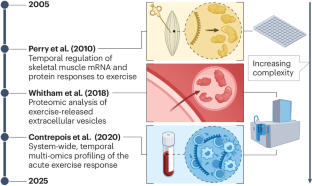二十年来人体运动代谢研究的进展
IF 40
1区 医学
Q1 ENDOCRINOLOGY & METABOLISM
引用次数: 0
摘要
在过去的20年里,分子生物学和基于组学的方法迅速推动了运动代谢学科的发展。在这里,我们研究了三项创新的人体代谢研究,这些研究增加了我们对运动在骨骼肌及其他部位的复杂分子景观的理解,并强调了未来的关键方向。本文章由计算机程序翻译,如有差异,请以英文原文为准。

Twenty years of progress in human exercise metabolism research
Molecular biology and omics-based approaches over the past 20 years have rapidly advanced the discipline of exercise metabolism. Here, we examine three innovative human metabolic studies that have increased our understanding of exercise’s complex molecular landscape in skeletal muscle and beyond, and highlight key future directions.
求助全文
通过发布文献求助,成功后即可免费获取论文全文。
去求助
来源期刊

Nature Reviews Endocrinology
医学-内分泌学与代谢
CiteScore
42.00
自引率
0.70%
发文量
158
审稿时长
6-12 weeks
期刊介绍:
Nature Reviews Endocrinology aspires to be the foremost platform for reviews and commentaries catering to the scientific communities it serves. The journal aims to publish articles characterized by authority, accessibility, and clarity, enhanced with easily understandable figures, tables, and other visual aids. The goal is to offer an unparalleled service to authors, referees, and readers, striving to maximize the usefulness and impact of each article. Nature Reviews Endocrinology publishes Research Highlights, Comments, News & Views, Reviews, Consensus Statements, and Perspectives relevant to researchers and clinicians in the fields of endocrinology and metabolism. Its broad scope ensures that the work it publishes reaches the widest possible audience.
 求助内容:
求助内容: 应助结果提醒方式:
应助结果提醒方式:


